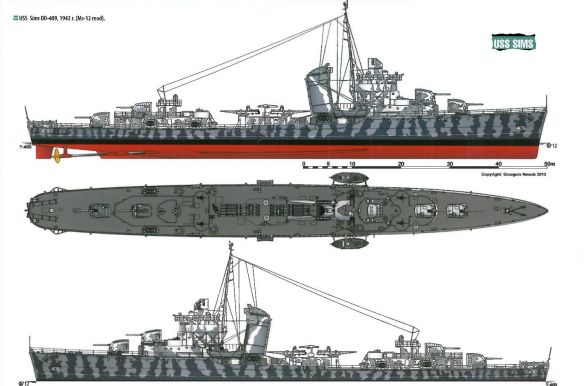SIMS CLASS
Historical Units: Sims, Hughes, Anderson, Hammann, Mustin, Russell, O’Brien, Walke, Morris, Roe, Wainwright, Buck.
Type and significance: This class of U. S. destroyer serves as an example of U. S. destroyer design upon the outbreak of World War II.
Dates of construction: All units were constructed between 1938 and 1939.
Hull dimensions: 348’4″ # 36′ # 12’10”
Displacement: 1,764 tons
Armor: None
Armament: Five 5″ guns, four .5″ AA weapons, eight 21″ torpedo tubes, and 10 depth charges.
Machinery: Turbines powered by three oil-fired boilers that produced 50,000 shaft horsepower.
Speed: 35 knots Complement: 190
Summary: All of the vessels in the class served in World War II. Sims, Hammann, O’Brien, Walke, and Buck were destroyed in the conflict. By 1948, the others were either scrapped or destroyed as test ships.
The high number of destroyers launched between 1935 and 1939 was spurred by rising world tensions and continued to include primarily large destroyers capable of extended operations in the Pacific. The first of these were eight ships of the Porter class, launched between 1935 and 1936, that filled the U. S. need for flotilla leaders. These can be classed as the first U. S. superdestroyers. The hull of Porter measured 381 feet, 1 inch by 37 feet by 13 feet, displaced 1,834 tons, and housed engines capable of 37 knots. Its armament consisted of eight 5-inch guns in four twin-gunned mounts that were fully enclosed by gun houses. Two of these were located in the bow while the other two were sited in the stern. As a result of this armament and the ship’s tonnage, Porter conformed to the London Treaty at a time that corresponded with the breakdown of the Second London Conference. The ship was also armed with eight 1.1-inch and two .5-inch AA guns as a reflection of the growing threat posed by the airplane. Finally, the vessel carried eight 21-inch torpedo tubes.
The Porter type was followed by six more classes launched up to the end of 1939 that yielded 52 new destroyers. The last of these, the Sims class, is an example of regular U.S. destroyer design upon the outbreak of war in Europe. The hull of Sims measured 348 feet, 4 inches by 36 feet by 12 feet, 10 inches and displaced 1,764 tons. It was armed with five 5-inch guns, four .5-inch AA weapons, and eight 21-inch torpedo tubes. The vessel’s engines generated a maximum speed of 35 knots.
In addition to ships of these general design specifications, the United States continued the production of superdestroyers. The Somers-class ships displaced 2,047 tons and carried an impressive primary armament of eight 5-inch guns and 12 21-inch torpedo tubes. The large displacement of these ships is evidence of the fact that by the time of their launching between 1937 and 1938 the United States had accepted the fact that the era of arms limitation was over. By this point, it was also clear to many that global conflict was once again a real possibility.
